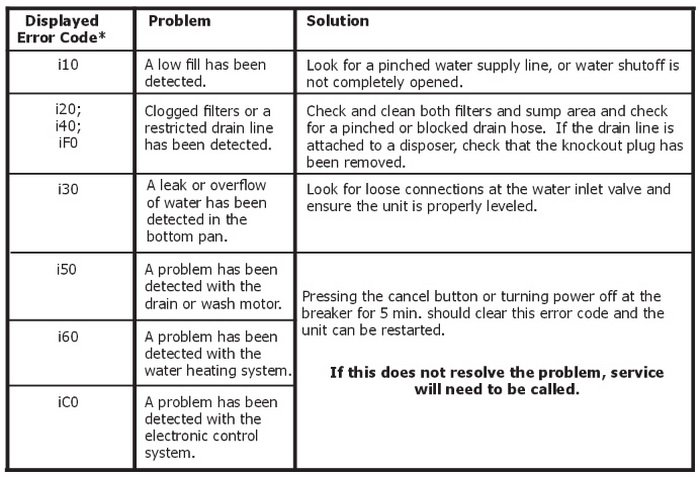
In the world of dishwashers, the F2 error code on a Frigidaire model generally relates to a drainage problem. Just like when your sink backs up due to a clog, this error indicates that the dishwasher isn’t draining water properly. If the water can’t escape the machine, it’s like trying to drink through a blocked straw—nothing is going anywhere. This malfunction can stem from a few different causes, which we’ll explore and address step by step, so you can get your dishwasher back to its efficient self.
Understanding the Error Code F2
So, what exactly does this F2 error code imply for your Frigidaire dishwasher? To put it simply, it’s your dishwasher’s way of signaling that there’s a drainage issue. Imagine if a bathtub didn’t let the water out; it would quickly become unusable. Likewise, your dishwasher can’t complete its cycles if the water inside has nowhere to go. The F2 code is essentially an SOS from your dishwasher saying, “Help, I’m full of water, and I can’t empty myself!”
The most common cause of this problem is a blockage somewhere in the drainage system. It could be something as simple as leftover food particles or a more serious obstruction like a kinked or blocked drain hose. Think of it like a traffic jam—until the road is clear, nothing can move forward. Unfortunately, it often means there’s standing water at the bottom of the dishwasher, and you don’t want that water sitting there longer than necessary as it can lead to bigger issues.
Another reason you might see the F2 error is a malfunctioning drain pump. The pump’s job is to push the wastewater out of the dishwasher, but if it fails, that water isn’t going anywhere. It’s like having a pump at a pool party that’s gone on strike; everyone’s still in the water because no one’s removing it! Knowing whether your issue is a pump failure or a blockage is the first step towards solving the dilemma.
How to Diagnose the F2 Error Code
Alright, let’s roll up our sleeves and get down to diagnosing this F2 code issue. First, let’s check for visible clogs or obstructions. Open your dishwasher and take a good look at the bottom. Is there standing water? Can you see any large food particles that could be the culprits? Sometimes, solving the problem is a matter of removing these visible blockages, akin to removing leaves from a gutter to prevent overflow.
Next, take a look at the drain hose, the conduit that leads water out of your dishwasher. If it’s kinked or blocked, water won’t drain properly. Imagine a garden hose with a twist in it; no matter how much you try, water just won’t squirt out efficiently. To check, you may need to carefully pull your dishwasher away from the wall and inspect the hose’s condition. Ensure it’s free from bends or dirt buildup.
Then, there’s the drain pump. This component can sometimes be the tricky part to assess. If you’re handy, you can try testing the pump to see if it’s functioning correctly. In some cases, you might hear the pump struggling or not engaging at all. If you suspect an issue here and feel out of your depth, calling a professional may be the best route. It’s like having a specialist look at your car engine—sometimes it’s best left to the pros.
Fixing the F2 Error: Step-by-Step Guide
Now that we’ve diagnosed, let’s dive into fixing the F2 error code. Start with the simple stuff: if you found an obvious clog or obstruction, remove it. Reassemble the dishwasher components and run a standard cycle to see if the issue resolves. It’s much like pulling out a wedged shoe from your car’s brake pedal; once removed, the system runs smoothly again.
If the drain hose was your problem, try straightening out any kinks or cleaning out the obstruction. You might need a brush to scrub away buildup or a gentle rinse with water to clear it up. Picture it like cleaning out an aquarium tube—clean pathways mean clear water flow. Reinstall the hose carefully, ensuring no sharp bends could impact its function.
However, if the pump was the issue and you’ve either confirmed this or can’t test it, replacing the pump might be necessary. While you can purchase a replacement pump online or through a local appliance part store, installing it might require professional help, especially if you’re not confident in your DIY skills. Think of it as calling an electrician for faulty wiring—sometimes it’s worth the peace of mind.
Preventing Future F2 Errors
So, how can you prevent this pesky F2 error in the future? Routine maintenance is key. Just like regularly cleaning and servicing your car keeps it running smoothly, doing so with your dishwasher will extend its life and functionality. Clean the filters after every few washes to ensure no food debris accumulates and causes blockages.
Make it a habit to scrape off large food particles before loading your dishes. It’s a bit like brushing the debris off your shoes before entering the house to prevent tracking in dirt. Furthermore, consider running a cleaning cycle with a dishwasher cleaner monthly. This keeps internal components clean and free from buildup, much like descaling a coffee maker.
Occasionally check the drain hose for kinks or buildup, ensuring it’s always in good condition. These simple acts of care can significantly reduce the chances of encountering that dreaded F2 error code again, leaving you with a more reliable appliance and, ultimately, less hassle in your daily routine.